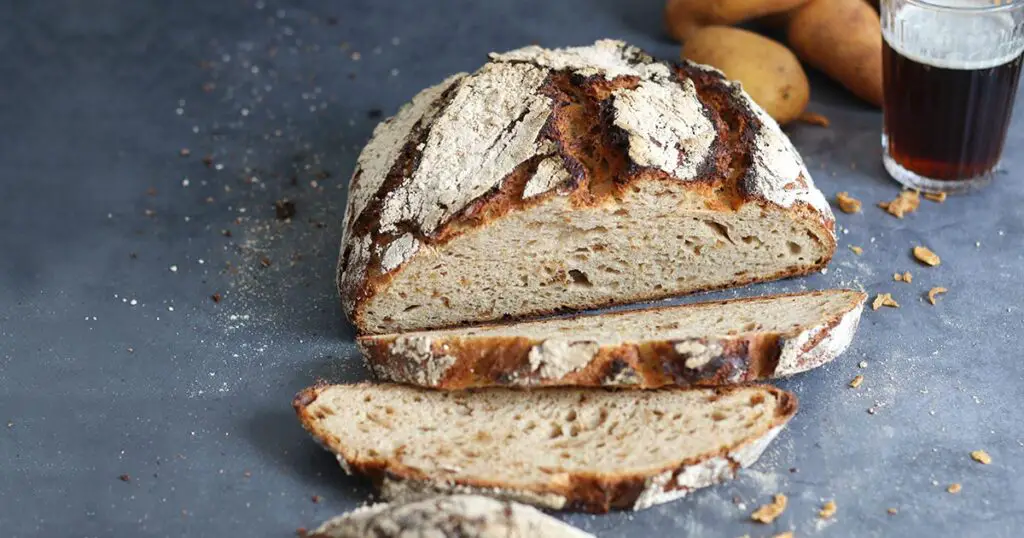Sourdough rye bread combines the tangy flavor of traditional sourdough with the robust earthiness of rye, making it a favorite among artisan bread enthusiasts. This guide will take you through the steps to create your own sourdough rye bread at home, from starter to oven.
Ingredients:
Rye Sourdough Starter:
100 grams active sourdough starter
100 grams rye flour
100 grams water
For the Bread:
400 grams rye flour
100 grams bread flour
350 grams water (adjust as needed for dough consistency)
10 grams salt
20 grams honey (optional, for a touch of sweetness)
Equipment:
Mixing bowls
Dough scraper
Kitchen scale
Bread proofing basket or bowl
Dutch oven or baking stone
Parchment paper
Oven
Instructions:
Prepare the Rye Sourdough Starter:
Combine the sourdough starter, rye flour, and water in a bowl. Mix until well incorporated.
Cover the bowl with a cloth and let it ferment at room temperature for 12 to 16 hours, or until bubbly and active.
Mix the Dough:
In a large mixing bowl, combine the rye flour, bread flour, water, salt, and honey. Mix until all the ingredients are combined.
Add the active rye sourdough starter to the flour mixture. Use your hands or a dough scraper to mix until the dough is well combined.
Depending on the dough’s hydration, adjust with a bit more water or flour to achieve a slightly sticky consistency.
Bulk Fermentation:
Cover the bowl with a damp cloth and let it ferment at room temperature for about 3 to 4 hours. During this time, perform stretch and folds every 30 minutes for the first 2 hours to strengthen the gluten network.
Shape the Bread:
After the bulk fermentation, gently turn the dough out onto a lightly floured surface.
Shape the dough into a round loaf, creating surface tension by pulling the dough underneath itself.
Proof the Bread:
Place the shaped dough into a floured proofing basket or a bowl lined with a floured cloth.
Cover and let it proof for 1 to 2 hours, or until it has noticeably puffed up but not doubled.
Preheat the Oven:
At least 30 minutes before baking, preheat the oven to 475°F (245°C). Place a Dutch oven or a baking stone inside to heat.
Bake the Bread:
Carefully remove the hot Dutch oven from the oven and line it with parchment paper.
Gently invert the proofed dough into the Dutch oven. Score the top with a sharp knife or lame.
Cover and bake for 30 minutes, then uncover and bake for another 10 to 20 minutes, until the crust is deeply browned and the internal temperature reaches about 210°F (99°C).
Cooling:
Remove the bread from the oven and let it cool on a wire rack for at least an hour before slicing. This rest time allows the crumb to set and the flavors to develop.
Tips for Success:
Rye Flour: Rye flour can make the dough sticky and more compact. Handle the dough with care and avoid adding too much flour during shaping.
Hydration: Due to the absorbent nature of rye flour, you might need to adjust the amount of water in your recipe based on the dough’s consistency.
Scoring: Rye breads are denser, so a deep score helps it expand in the oven.
Baking sourdough rye bread is a rewarding experience that yields a loaf full of flavor and texture. By following these steps and making adjustments based on your observations, you’ll be able to bake a perfect sourdough rye bread that boasts a crispy crust and a tangy, moist crumb. Enjoy it fresh or as the base for a variety of delicious sandwiches.
Storing and Enjoying Your Sourdough Rye Bread
Once you’ve mastered the art of baking sourdough rye bread, you’ll want to ensure it stays fresh and delicious as long as possible.
Storing Tips:
Room Temperature: Keep the bread in a bread box or wrapped in a cloth in a cool, dry place. It should last for about 3-4 days.
Refrigerate: While refrigeration can dry out the bread, it can help prevent mold if you’re in a very humid environment. Wrap it tightly in plastic wrap or a resealable bag if you choose this method.
Freeze: For longer storage, slice the bread and freeze it in airtight bags. You can toast slices directly from frozen, making this a convenient option.
Enjoying Your Bread:
Toasting: Sourdough rye bread makes excellent toast. The heat caramelizes the sugars in the bread, enhancing its natural flavors.
Sandwiches: Its robust flavor and texture make it an ideal base for sandwiches with strong flavors like smoked salmon, cream cheese, or pastrami.
With Soups: This bread pairs wonderfully with hearty soups and stews. Its dense crumb holds up well when dunked into broths.
Troubleshooting Common Issues
Even with careful preparation, sometimes you may encounter issues. Here are solutions to some common bread baking problems:
Dense Crumb: If your bread is too dense, it might be due to insufficient fermentation or not enough water in the dough. Ensure your starter is active and consider increasing hydration slightly.
Bread Not Rising: This often indicates that the starter was not active enough. Make sure your starter is bubbly and doubles in size before using it in your recipe.
Crust Too Thick or Hard: If your crust is too thick or hard, try reducing the baking time or lowering the oven temperature after removing the lid from the Dutch oven. Also, ensure there is enough steam during the initial baking phase.
Experimenting with Variations
Once you’re comfortable with the basic recipe, you can start experimenting with variations to tailor the bread to your taste:
Adding Seeds: Incorporate sunflower seeds, flaxseeds, or pumpkin seeds into the dough for extra texture and flavor.
Herbs and Spices: Consider adding caraway seeds, anise, or fennel seeds to enhance the bread’s flavor profile.
Whole Grains: Mix in some whole grain rye or other whole flours like wheat for a different texture and a nutritional boost.
Baking sourdough rye bread is a fulfilling hobby that not only feeds the body but also the soul. Each loaf is a testament to patience and care, offering a hearty, satisfying experience that’s hard to replicate with store-bought bread. By understanding the basics and embracing variations, you can make each bake a reflection of your culinary creativity and passion. Enjoy the process and the delicious outcomes!




